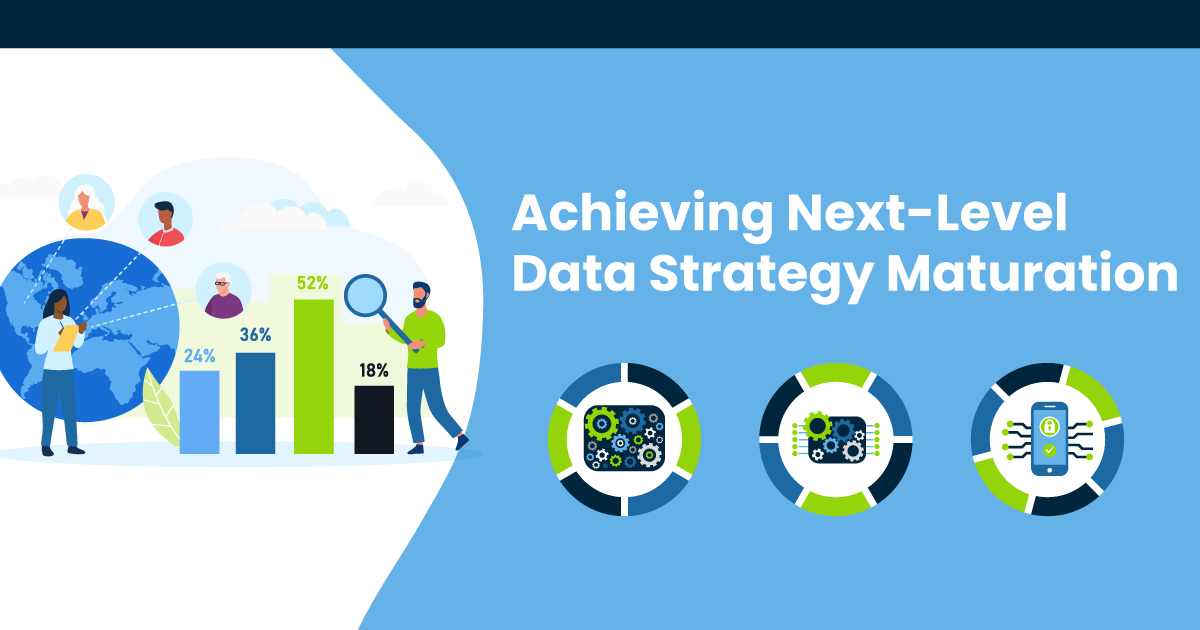
Achieving Next-Level Data Strategy Maturation
Insurance leaders have long recognized data’s immense potential, and now they’re developing initiatives to harness its analytical power. Data strategies are not new, but they have reached a turning point. Continued progress will require next-level data strategy maturation.
What Does Data Strategy Maturation Look Like?
Generally, data maturity is described in the following three phases:
- Descriptive Analytics: Using historical data to describe what happened in the past or present. This involves collecting raw data, cleaning the data and building standard and ad hoc reporting tools.
- Predictive Analytics: Analyzing past data patterns and trends to forecast what will happen in the future.
- Prescriptive Analytics: Apply rules, statistics and algorithms to data to evaluate potential scenarios and recommend courses of action.
In a 2022 insurance industry study, Deloitte1 describes insurers as falling into three data strategy maturity buckets: Explorers, Adopters and Pioneers.
- Explorers leverage data to better assess and price risk. They also use data to cut loss costs through fraud detection and claims management.
- Adopters use data to pursue revenue growth and additional market share and routinely use data to drive strategic decisions.
- Pioneers continuously invest in data and analytics as strategic assets used to enhance most business processes.
Where the Insurance Industry Stands
In the Deloitte study1, only 6% of insurers describe their organizations as being in stage 3 of data maturation – Pioneers.
Despite the fact that many insurers have invested in data initiatives, it’s clear that just having data is not enough. Many insurers are still unable to fully leverage their data and move to their next level of data maturity because of challenges that include:
- Access to quality data. Many insurers have data stored in a variety of disparate systems, making it very challenging to compile the complete picture. Those that view data as a strategic asset and recognize that complete data is crucial, have invested in data governance initiatives, according to Deloitte.1
- Dirty data. Data must be trustworthy. Before insurers can use data to drive agile decisions, they need to clean it. There may be duplicate records, missing fields and other inaccuracies that can skew analytics.
- Biased data. Data can also be biased, meaning the results can be misleading or inaccurate – often because the sample is not representative of the population.
- Data illiteracy and change resistance. Many times, people are the biggest challenge. The Data Literacy Project2 found that 11% of employees are not confident in their ability to read, analyze, work with, and communicate data, whereas 45% of executives say they act on gut instinct. If people don’t have the necessary data literacy or don’t trust data enough to want to use it, data won’t achieve its potential.
Where the Insurance Industry is Headed
For the insurance industry, data’s real potential depends on moving beyond descriptive analytics to the use of predictive and prescriptive analytics. When insurance leaders can forecast the likelihood of future events with predictive analytics and then chart the best course of action using prescriptive analytics, we will see powerful transformation resulting from data initiatives.
According to the NAIC3, insurers can use data to improve underwriting, enrich the customer experience, boost marketing effectiveness, increase operating effectiveness, facilitate better claims processing, and reduce fraud.
A 2022 Deloitte survey1 found that insurers’ data strategy is more developed in the areas of core claims, underwriting and actuarial operations.
Building a Data-Driven Culture
Data can only inform insurance decisions if leaders trust the data. We’ve already learned that 45% of executives act on gut instinct. Having AI-powered analytics won’t help if decision makers ignore the information. When prescriptive analytics conflict with human instinct, there is a strong opportunity for disruptive change in which organizations could tackle old challenges in new ways.
However, building a data-driven culture must start at the top. In 2022, Gartner Research4 found that chief data and analytics officers are failing to address data literacy within their organizations and that organizational culture is a prevalent roadblock to the success of data and analytics teams.
How to Move Forward
To achieve next-level data strategy maturation, the insurance industry needs to overcome certain cultural obstacles and adopt a new data mindset.
- Insurers need a long-term strategy that focuses on the big picture. According to Deloitte1, insurers tend to view data as a short-term expense associated with individual functions and projects. It’s time to think bigger. Instead of compartmentalizing data in siloed systems, insurers must focus on holistic data strategies.
- Leaders need to be willing to embrace real change. People tend to stick with old ways of doing things, which can impede progress. For example, instead of taking a comprehensive approach that revolutionizes insurance processes, they may implement piecemeal changes that only offer minor improvements but add to the organization’s complexity and technology bloat.
- The new data mindset must be embraced at every level. Problems can also occur when an organization adopts new systems but individual workers keep doing things the old way. This results in wasted resources and continued operational inefficiencies. Data can bring about tremendous advantages if everyone is willing to embrace true change.
Partnering with One Inc
One Inc is here to help you on your digital journey. Our Client Success Team actively partners with clients to optimize their payment transformation by providing digital payment data and metrics, along with best-in-class carrier benchmarking. With One Inc at your side, continually adding value, digital transformation success is achievable.
Contact us to learn more.
Source:
- https://www2.deloitte.com/us/en/insights/industry/financial-services/insurance-data-as-a-strategic-asset.html
- https://thedataliteracyproject.org/
- https://content.naic.org/cipr-topics/big-data
- https://www.gartner.com/en/doc/00770015-roles-and-skills-to-support-advanced-analytics-and-ai-initiatives/address-both-skill-and-will-to-deliver-data-driven-business-change
- https://www.gartner.com/en/information-technology/insights/data-and-analytics-essential-guides
Tags: Industry Trends, AI, Big Data

Written by The One Inc Content Team
The One Inc Content Team strives to provide valuable insights about digital trends and payments innovation for the insurance community.
Want to read more articles like this?

